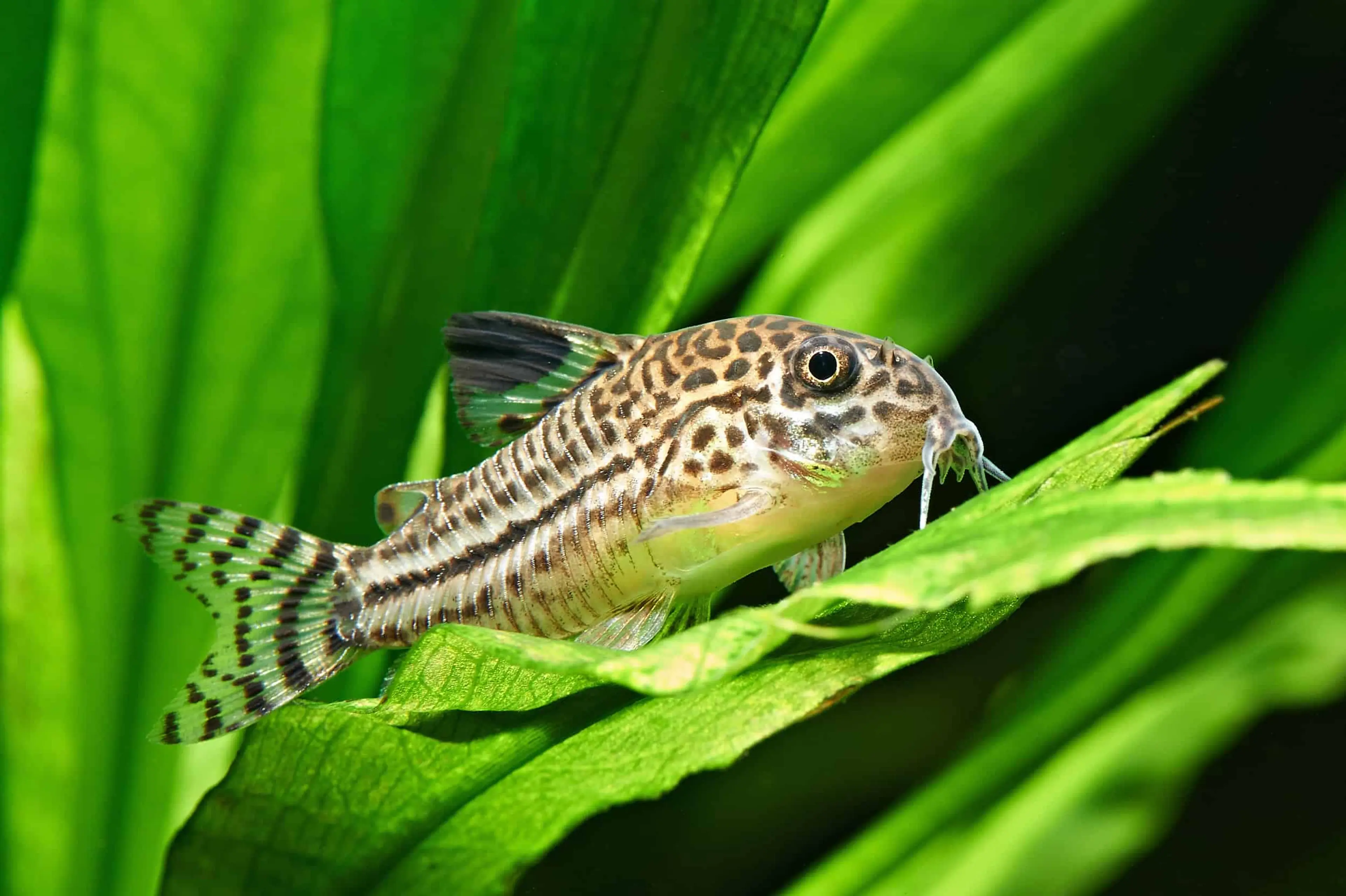Ah, the humble Cory catfish, also known as the armored catfish, the armored cat, or the Corydoras, is a favorite among aquarium enthusiasts. These little guys have been swimming around in freshwater aquariums for over a century now, and it's no wonder why - they're adorable, peaceful, and easy to care for!
So, if you're thinking about adding some Cory catfish to your aquarium, you're in for a treat. In this guide, we'll cover everything you need to know about these delightful little fish, from their origins and history to their care and breeding. So, let's dive in!
Origins and History
The Cory catfish is a genus of freshwater fish that belongs to the Callichthyidae family. They are native to South and Central America, where they inhabit rivers, streams, and flooded forests. The first recorded instance of the Cory catfish being kept in an aquarium dates back to the early 1900s, and they have been popular among fishkeepers ever since.
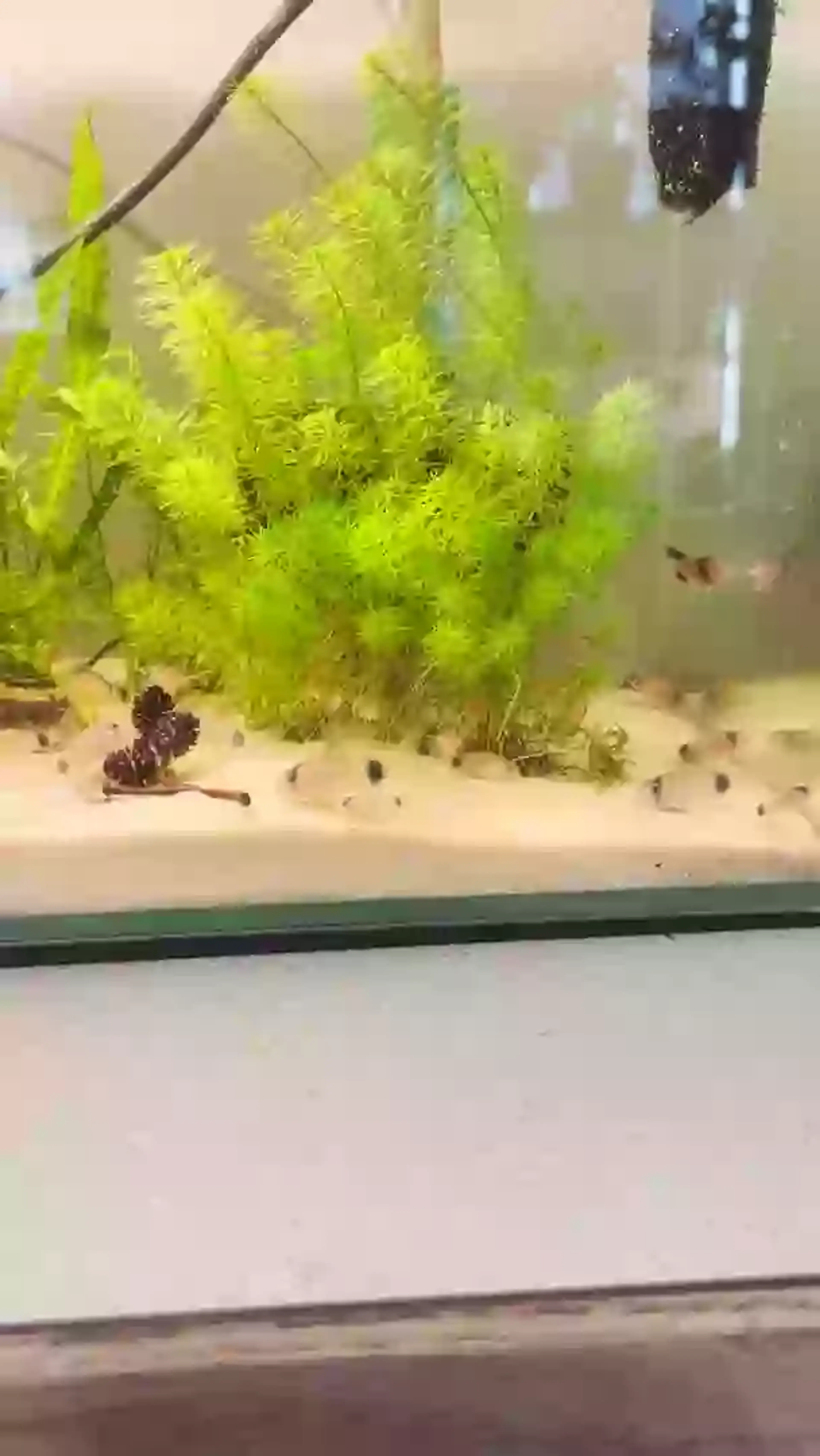
Cory catfish come in a variety of species, each with its own unique characteristics. Some of the most common species include the bronze Cory catfish, the panda Cory catfish, the peppered Cory catfish, and the emerald Cory catfish. These fish are small and generally peaceful, making them a great addition to any community aquarium.
Fun fact: The Cory catfish is named after Ichthyologist Charles Cory, who was an avid collector of fish specimens in South America during the late 1800s.
Species
There are over 170 different species of Cory catfish, each with their own unique characteristics and traits. Here are a few of the most common species you may come across:
Bronze Cory Catfish (Corydoras aeneus): The Bronze Cory is a popular species among fishkeepers, with its shiny bronze scales and adorable little face. They are peaceful and easy to care for, making them a great addition to any community aquarium.
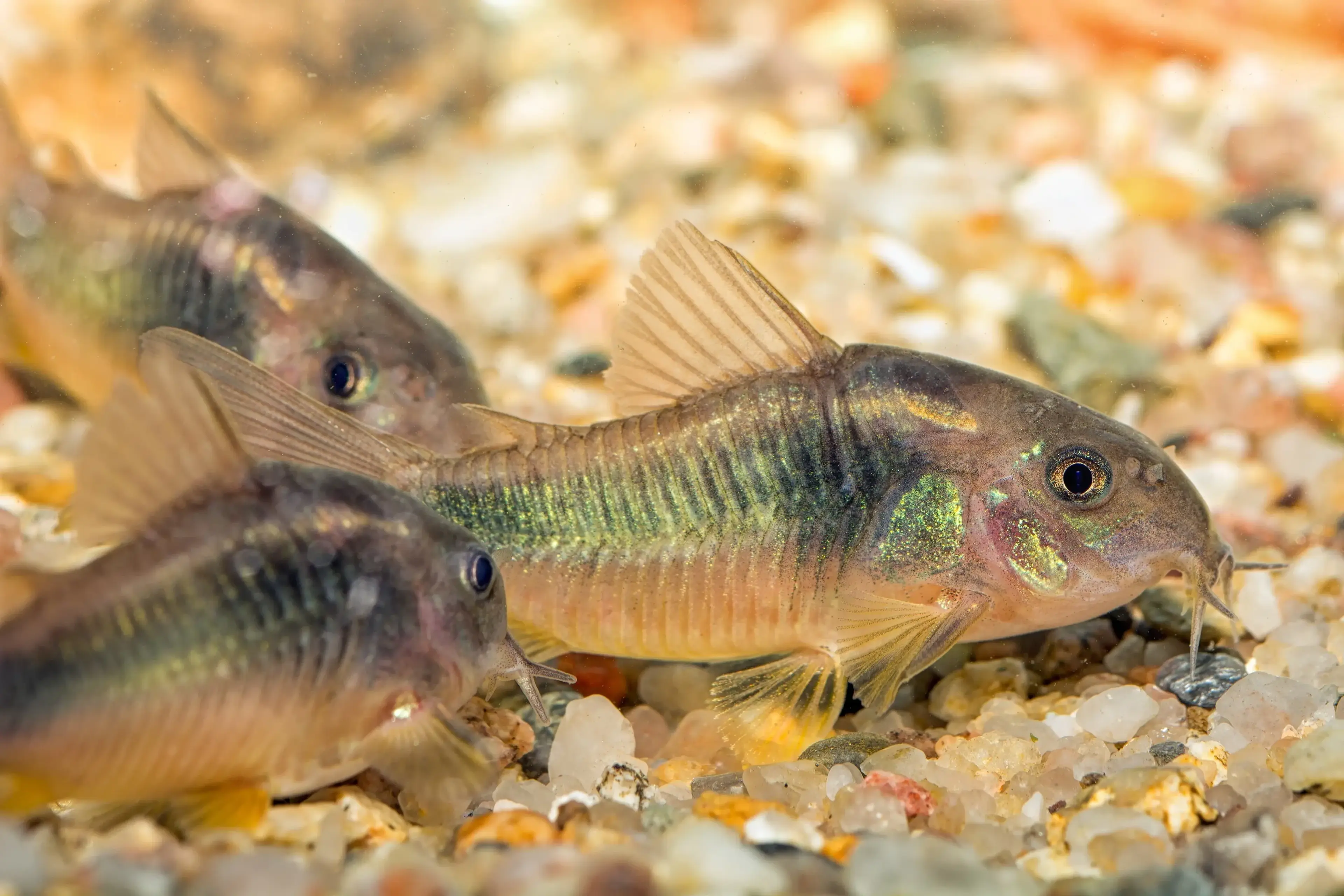
Panda Cory Catfish (Corydoras panda): The Panda Cory is a black and white catfish that looks like it's wearing a little mask. They are social creatures and should be kept in groups of six or more.
Peppered Cory Catfish (Corydoras paleatus): The Peppered Cory is a small, peaceful catfish with a beautiful silver and black peppered pattern on its scales. They are easy to care for and make great community tank mates.
Emerald Cory Catfish (Corydoras splendens): The Emerald Cory is a stunning green catfish with bright red eyes. They are peaceful and should be kept in groups of six or more.
No matter which species you choose, Cory catfish are a great addition to any aquarium. They are small, peaceful, and fun to watch as they scuttle across the bottom of the tank in search of food.
| Species | |
| Name: | Cory catfish |
| Family: | Callichthyidae |
| Origin: | South and Central America |
| Care | |
| Care level: | Beginner-friendly |
| Life span: | up to 5 years |
| Diet | |
| Diet | Algae, Blanched vegetables, Algae wafers, Brine shrimp, Blood worms, Daphnia |
| Behavior | |
| Temperament: | Peaceful community fish |
| Activity: | Active forager |
| Breeding: | Egg layer |
| Aquarium | |
| Tank size: | 20 gallons |
| 76 liters | |
| Tank level: | Bottom dweller |
| Flow rate: | Medium |
| Planted tank: | Likes a well planted tank |
| Aquarium parameters | |
| Temperature: | 72-78℉ |
| 22-26℃ | |
| pH Range: | 6-8 |
Tank setup
When it comes to setting up a tank for your Cory catfish, there are a few things to keep in mind. First and foremost, you'll want to make sure the tank is big enough to accommodate your fish. Cory catfish are social creatures and should be kept in groups of six or more, so you'll want to make sure your tank is large enough to support a school of fish.
In terms of tank size, a good rule of thumb is to have a minimum of 20 gallons for every six Cory catfish. However, if you can afford a larger tank, your fish will thank you for it!
Next, you'll want to make sure the tank is properly equipped. Cory catfish love to hide and explore, so you'll want to provide them with plenty of hiding spots, such as caves, plants, and driftwood. They also enjoy a sandy substrate, as it mimics the natural environment they would live in in the wild.

When it comes to filtration, a good quality filter is essential to keeping your Cory catfish healthy and happy. Cory catfish are sensitive to high levels of ammonia and nitrites, so you'll want to make sure your filter is capable of handling the bioload of your tank. A gentle filter flow is also important, as Cory catfish are not strong swimmers and can easily be knocked around by strong currents.
Lastly, lighting is also important for your tank. Cory catfish do best in a dimly lit environment, so you'll want to choose a low to moderate lighting option for your tank. This can be achieved with the use of floating plants or dimming the aquarium lights.
Overall, creating a suitable environment for your Cory catfish involves providing plenty of hiding spots, a sandy substrate, gentle filtration, and dim lighting. By following these guidelines, you'll create a happy and healthy home for your fish.
Water parameters
Cory catfish are native to South America, where they inhabit slow-moving rivers, streams, and flooded forests. This means that they prefer soft, slightly acidic water with a pH range between 6.0 and 7.5. The temperature of the water should be kept between 72-78°F (22-26°C), with a hardness level between 2-15 dGH.
It's important to note that Cory catfish are sensitive to changes in water conditions, so maintaining stable water parameters is crucial for their health and well-being. You should regularly test the water in your aquarium using a reliable test kit to make sure the parameters are within the recommended range.
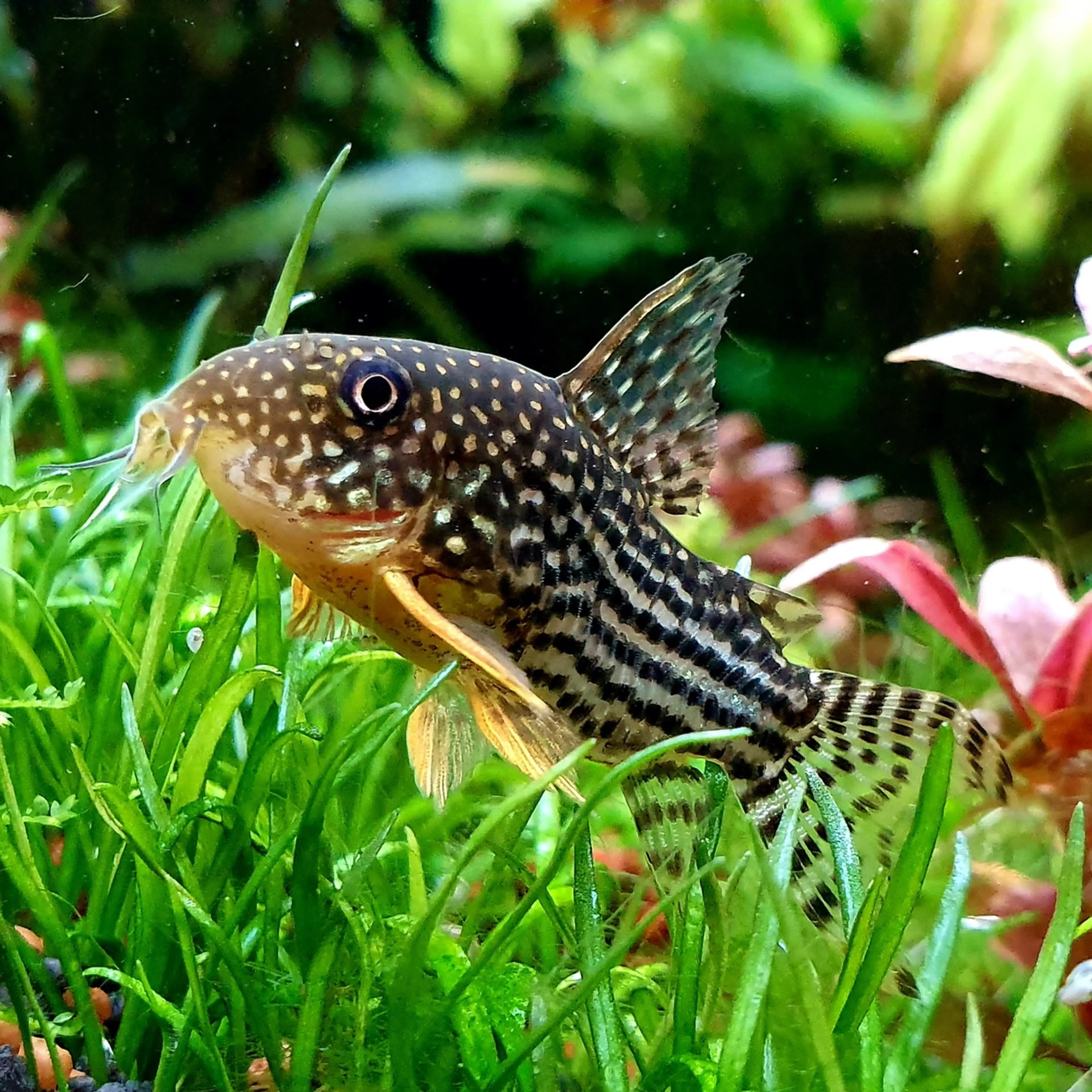
In addition to water chemistry, you'll also want to make sure the water in your tank is clean and free from harmful substances. This can be achieved through regular water changes and the use of a quality filter. Aim to perform weekly water changes of 20-25% to remove any excess waste and debris from the tank.
One important thing to keep in mind when it comes to water parameters is that different species of Cory catfish may have slightly different requirements. It's important to research the specific species you plan to keep and adjust your water parameters accordingly.
Overall, maintaining stable water parameters with a slightly acidic pH, soft water, and a temperature range of 72-78°F (22-26°C) is crucial for the health and well-being of your Cory catfish.
Feeding
Cory catfish are omnivorous and will eat a variety of foods. In the wild, they primarily feed on insects, crustaceans, and plant matter. In the aquarium, you can feed them a combination of commercial fish food like algea wafers, frozen or live foods, and vegetables.
A good quality commercial fish food that contains a mix of protein, fiber, and vitamins is a great staple for your Cory catfish's diet. Look for fish foods that are specifically formulated for bottom feeders, as these will sink to the bottom of the tank where your Cory catfish will feed.
In addition to commercial fish food, you can also offer your Cory catfish frozen or live foods such as brine shrimp, bloodworms, and daphnia. These foods are a great source of protein and will help to keep your fish healthy and happy.
Cory catfish also enjoy eating vegetables, such as blanched zucchini, green peas or cucumber. Simply slice the vegetable and boil it for a few minutes until it's soft. Then, let it cool and place it in the tank. Your Cory catfish will love nibbling on the soft vegetable.
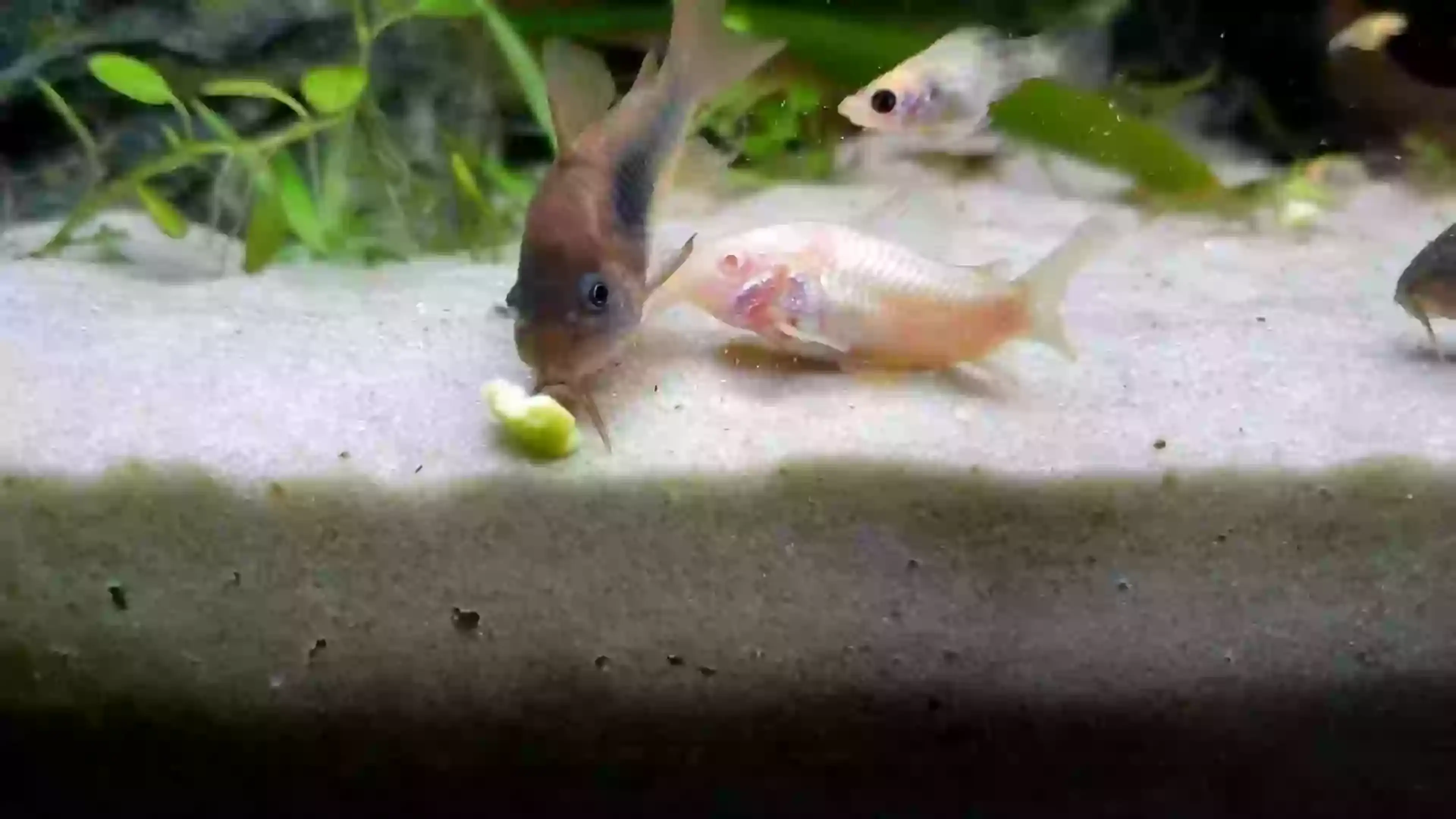
When it comes to feeding your Cory catfish, it's important not to overfeed them. Only feed them what they can eat in a few minutes, and remove any uneaten food to prevent it from fouling the water. A good feeding schedule is to feed your fish once or twice a day, depending on their age and activity level.
Overall, feeding your Cory catfish a balanced diet of commercial fish food, frozen or live foods, and vegetables is key to keeping them healthy and happy.
Behavior and Compatibility
Cory catfish are generally peaceful and sociable fish that enjoy living in groups of six or more. They are bottom dwellers and spend a lot of time scavenging for food in the substrate. They're also known for their playful and curious behavior, often seen swimming around the tank and exploring their environment.
When it comes to compatibility, Cory catfish are usually compatible with most peaceful community fish. Avoid keeping them with aggressive or territorial species that may bully or harm them. Good tankmates for Cory catfish include small tetras, guppies, and other peaceful community fish.
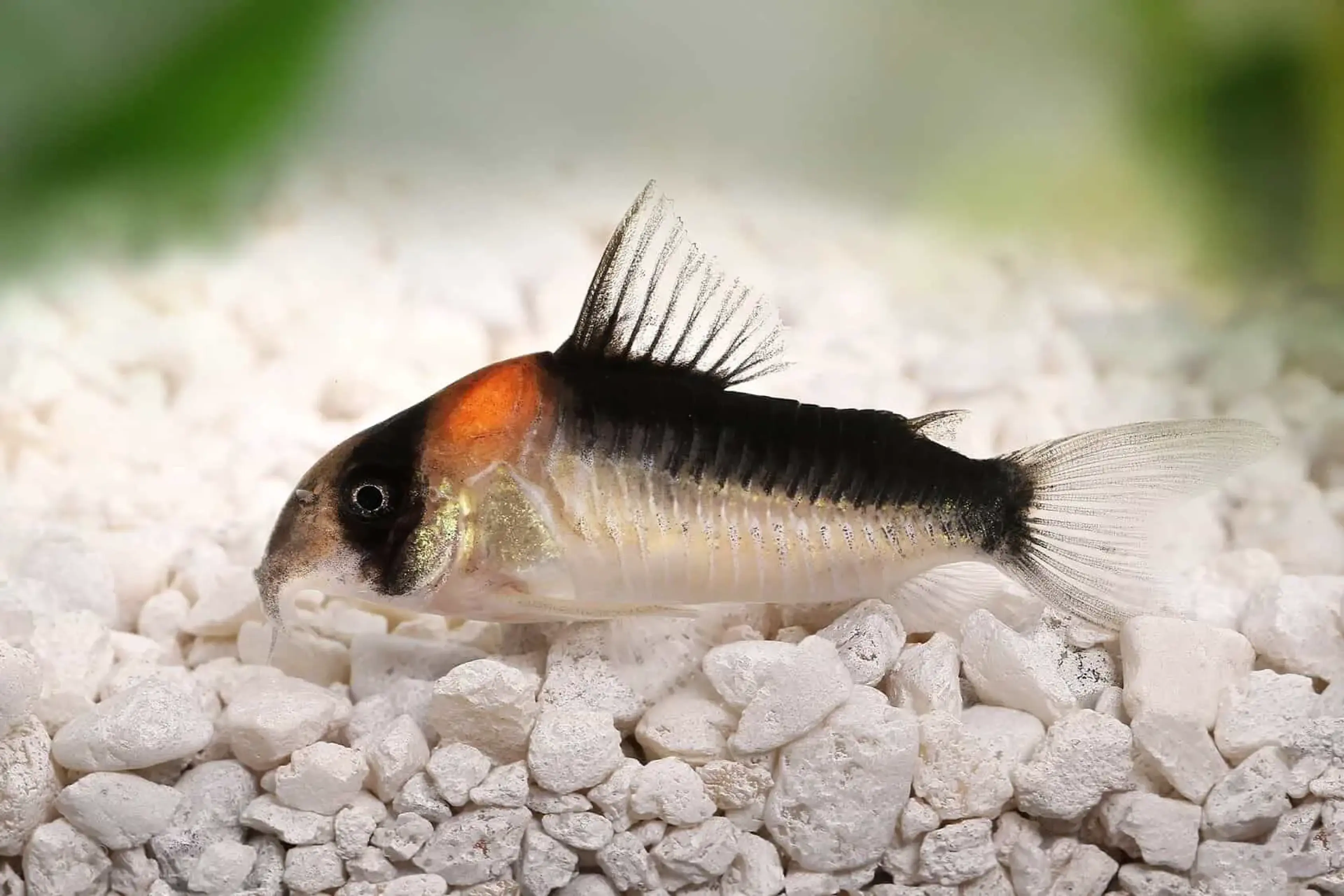
It's important to keep in mind that while Cory catfish are generally peaceful, they may become stressed if they're kept alone or in too small of a group. Make sure to provide them with plenty of hiding spots, such as caves or plants, where they can retreat if they feel threatened or stressed.
Overall, Cory catfish are peaceful, sociable fish that enjoy living in groups and are compatible with most peaceful community fish. Providing them with plenty of hiding spots and companionship will help keep them happy and stress-free in the aquarium.
Diseases and Treatment
Cory catfish are generally hardy fish, but like any other fish, they can become susceptible to various diseases and health problems. Here are a few common diseases that Cory catfish may experience:
- Ich - A common parasite that causes white spots to appear on the fish's body.
- Fin Rot - A bacterial infection that causes the fins to become frayed and discolored.
- Dropsy - A condition caused by a bacterial infection that causes the fish to develop a swollen belly.
- Swim Bladder Disease - A condition that causes the fish to have difficulty swimming upright.
If you notice any signs of illness in your Cory catfish, it's important to take action immediately. The best way to prevent disease is to maintain good water quality and hygiene in the aquarium. Regular water changes and proper filtration will help keep your fish healthy.
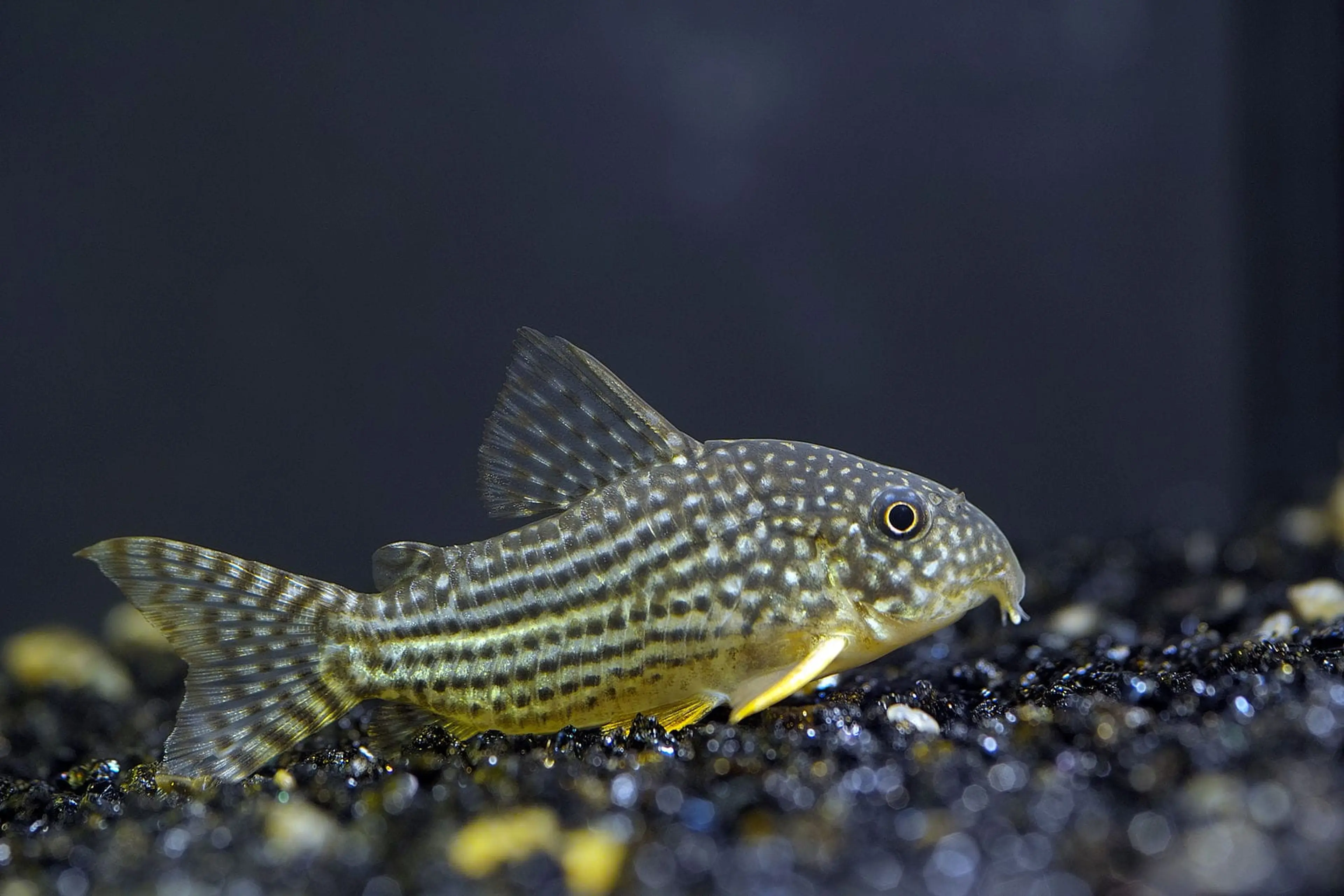
If your fish does become sick, you can treat them with medication specifically designed for the particular illness. Make sure to follow the instructions carefully and complete the full treatment as recommended. You may also want to consider isolating the sick fish in a separate quarantine tank to prevent the spread of disease to other fish in the aquarium.
Overall, prevention is key when it comes to keeping your Cory catfish healthy. By maintaining good water quality and hygiene in the aquarium, and monitoring your fish for signs of illness, you can help ensure that your Cory catfish stays happy and healthy.
Breeding
Breeding Cory catfish is a fascinating and rewarding experience. Before you begin, it's important to make sure that you have a suitable breeding setup. You'll need a separate breeding tank that's at least 10 gallons in size, with a smooth, flat substrate and plenty of hiding spots such as caves or plants.
To encourage breeding, you'll need to simulate their natural breeding conditions. Cory catfish prefer slightly cooler water temperatures (around 75-80°F), and a pH level of 6.5-7.0. You can also lower the water level and increase the flow rate to simulate the rainy season, which is when Cory catfish typically breed in the wild.
Once you've set up the breeding tank, you'll need to select a male and female Cory catfish. The easiest way to do this is to observe their behavior. Male Cory catfish are usually smaller and more slender than females, and they will often chase and nuzzle the females during breeding.
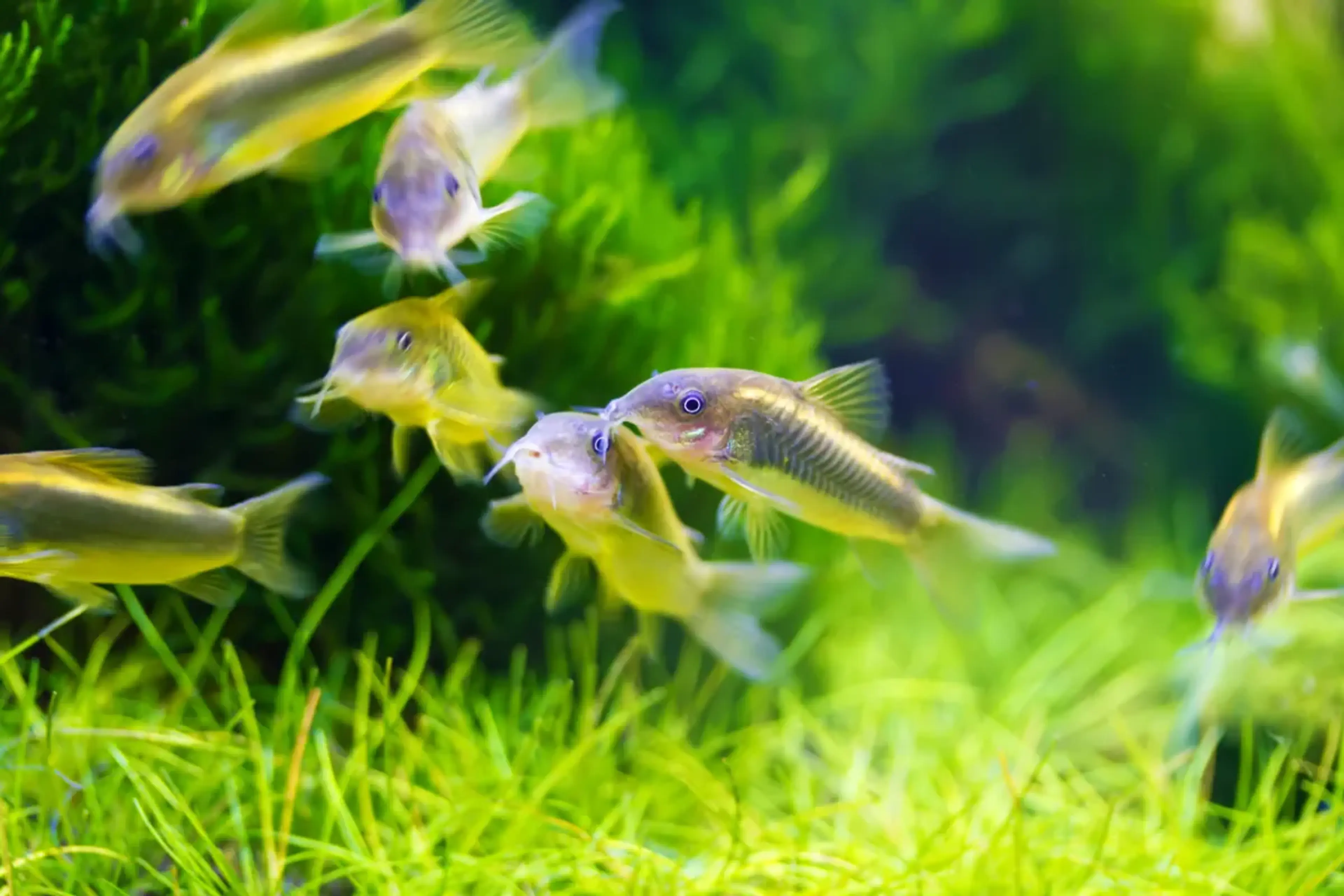
To encourage breeding, you can also feed your Cory catfish a varied diet of high-quality foods such as live or frozen brine shrimp and daphnia. This will help to stimulate their reproductive system and increase the likelihood of breeding.
If successful, the female Cory catfish will lay eggs on a flat surface in the breeding tank, such as the substrate or a leaf. The male will then fertilize the eggs. After a few days, the eggs will hatch into tiny fry that can be fed on newly hatched brine shrimp or commercially available fry food.
Breeding Cory catfish can be a rewarding experience, but it does require some patience and attention to detail. With the right setup and conditions, you can successfully breed and raise healthy Cory catfish fry in your own home aquarium.
Trivia
Here are some fun trivia facts about Cory catfish:
- Cory catfish are named after ichthyologist Charles Cory, who first described the fish in 1878.
- Cory catfish are sometimes referred to as "armored catfish" due to their bony plates that cover their bodies.
- There are over 170 known species of Cory catfish, with new species being discovered every year.
- Cory catfish are naturally found in the Amazon River basin and other freshwater rivers and streams in South America.
- Cory catfish are peaceful and social fish, and are often kept in groups of 3-6 in aquariums
- Cory catfish have a unique way of breathing called "accessory breathing organs," which allows them to take in air from the surface of the water.
- Cory catfish are omnivores and will eat a variety of foods, including algae, insects, and small crustaceans.
- Cory catfish have a unique swimming style where they swim along the bottom of the aquarium, often in a "shoaling" behavior where they swim closely together.
- Cory catfish have been known to live up to 20 years in captivity with proper care and maintenance.
- Cory catfish have become popular in the aquarium hobby due to their unique appearance, peaceful nature, and interesting behaviors.
So there you have it, some fun and interesting trivia facts about Cory catfish!
Conclusion
In conclusion, keeping Cory catfish in an aquarium can be a fascinating and rewarding experience for fish enthusiasts of all levels. These peaceful and social fish are known for their unique appearance, interesting behaviors, and compatibility with a wide range of other fish species.
To keep Cory catfish healthy and thriving, it's important to provide them with a suitable tank setup, optimal water parameters, and a varied diet. By mimicking their natural environment and providing plenty of hiding spots, you can encourage these fish to thrive and even breed in your home aquarium.
With proper care and attention, Cory catfish can live for many years and provide endless entertainment and enjoyment for their owners. So whether you're a seasoned fish keeper or a beginner, consider adding these fascinating fish to your aquarium and enjoy the unique beauty and charm of the Cory catfish.
